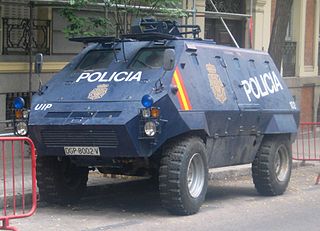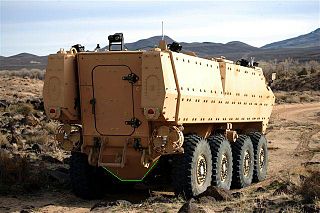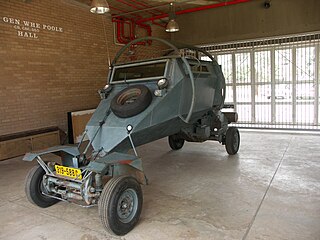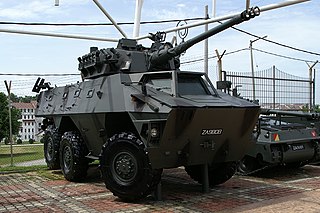
The Casspir is a Mine-Resistant Ambush Protected Vehicle that has been in use in South Africa since the 1980s. It is a four-wheeled, four-wheel drive vehicle, used for transport of troops. It can hold a crew of two, plus 12 additional soldiers and associated equipment. The Casspir was unique in design when launched, providing for passive mine defence. The main armoured steel body of the vehicle is raised high above the ground, so when a mine is detonated, the explosion is less likely to damage the crew compartment and kill the occupants. The cross-section of the hull is V-shaped, directing the force of the explosion outwards, further protecting the occupants.

The Mamba is a South African armoured personnel carrier designed for internal security purposes. It was developed during the late 1980s to replace the Buffel in service with the South African military and security forces. The first models were built on a 4X2 Toyota Dyna chassis, which was subsequently replaced in production around 1994 by a more reliable Unimog chassis. All marks of the Mamba were designed to be mine-resistant and blastproof.

The RG-31 Nyala is a 4×4 multi-purpose mine-resistant ambush protected infantry mobility vehicle manufactured in South Africa by Land Systems OMC and in Turkey by FNSS Defence Systems. It is based on the Mamba APC of TFM Industries.

The BTR-152 is a six-wheeled Soviet armored personnel carrier (APC) built on the chassis and drive train of a ZIS-151 utility truck. It entered service with a number of Warsaw Pact member states beginning in 1950, and formed the mainstay of Soviet motor rifle battalions until the advent of the amphibious BTR-60 series during the 1960s. BTR stands for bronetransportyor.

The RG-12 is a multi-purpose armoured personnel carrier with anti-personnel mine, grenade, fire bomb and small arms fire protection that is manufactured by Land Systems OMC of South Africa, with over 700 being in service globally in more than eight countries.

The EE-11 Urutu is a Brazilian amphibious armored personnel carrier. It was based on the drive train and chassis components of the EE-9 Cascavel armored car and initially emerged as part of a project to develop an amphibious troop-carrying counterpart to that vehicle for the Brazilian Army and Marine Corps (CFN). The first pre-production models entered service with the CFN in 1973 and serial production commenced the following year. While the CFN declined to adopt the EE-11 Urutu in large numbers, the Brazilian Army was more forthcoming and purchased 223; these entered service in 1975.

The Ferret armoured car, also commonly called the Ferret scout car, is a British armoured fighting vehicle designed and built for reconnaissance purposes. The Ferret was produced between 1952 and 1971 by the UK company Daimler. It was widely used by regiments in the British Army, as well as the RAF Regiment and Commonwealth countries throughout the period.

The Type 63 is a Chinese armoured personnel carrier that entered service in the late 1960s. It was the first armoured vehicle designed in China without Soviet assistance. The design is simple and is comparable to other APCs of its time such as the M113.

The Thyssen Henschel UR-416 is a German armoured personnel carrier, first introduced in 1969 and based on the body of the Mercedes-Benz Unimog light truck.

The V-hull is a type of vehicle armor design used on wheeled armored personnel carriers (APCs), infantry mobility vehicles, infantry fighting vehicles (IFVs) and MRAPs. The design originated in the 1970s with vehicles such as the iconic Casspir used extensively during the South African Border War, Leopard security vehicle used in the Rhodesian Bush War and South African armored vehicle company Land Systems OMCs and Buffels.

The Sri Lanka Electrical and Mechanical Engineers (SLEME) (Sinhala: ශ්රී ලංකා විදුලි හා යාන්ත්රික ඉංජිනේරු රෙජිමේන්තුව Shri Lanka Viduli Ha Yanthrika Injineru Rejimentuwa) is a Combat Support corps of the Sri Lanka Army. It is made up of six regular regiments and one volunteer (reserve) regiment. Regiment Center located at Kew Road, Slave Island, Colombo. The present strength of the corps is 200 officers and 5763 other ranks.

The Unibuffel is a mine-protected wheeled MRAP Infantry mobility vehicle used by the Sri Lankan military, which is an improved version of the Unicorn, made by the Sri Lanka Electrical and Mechanical Engineers.

The Unicorn is a MRAP used by the Sri Lankan military based on the Buffel, which is made by the Sri Lanka Electrical and Mechanical Engineers.

The Leopard Security Vehicle is an unusual land-mine protected APC used by the Rhodesian Government and civilian population during the 1964-1979 Rhodesian Bush War. It offered basic but necessary protection against mine attack through the use of a V-hull.

The Mine Protected Combat Vehicle – MPCV was a Rhodesian 4×4 Infantry fighting vehicle (IFV), first introduced in 1979 and based on the body of the Mercedes-Benz Unimog light truck. It remains in use with the Zimbabwe National Army.
The Bullet Troop-Carrying Vehicle (TCV) is a light 4x4 infantry fighting vehicle (IFV) developed by Rhodesia in the late 1970s based on the body of the Mercedes-Benz Unimog light truck.

The SIBMAS is a Belgian amphibious infantry fighting vehicle. It was engineered from the same prototype as the South African Ratel. In appearance the vehicle is also similar to the Chinese WZ-523 armoured personnel carrier. The SIBMAS was developed between 1975 and 1976 at a department of the BN Constructions Ferroviaires et Metalliques in Nivelles. Production was on an order-by-order basis and commenced only for the Malaysian Army.
UniAVALON or simply Avalon is a Sri Lankan 6×6 wheeled MRAP-type heavy armored personnel carrier manufactured by Sri Lanka Electrical and Mechanical Engineers (SLEME).

The SAMIL 20 is a 2-ton cargo vehicle produced in South Africa in the mid-1980s and was used as the primary light cargo carrier of the South African National Defence Force. The vehicle design is based on the German Mercedes Unimog chassis and Mark I of this vehicle was based on the Magirus Deutz 130M7FAL 4x4 truck. In Mark II, the engine was replaced with an upgraded South African built water cooled diesel engine. The vehicle is still in use with the SANDF.






















